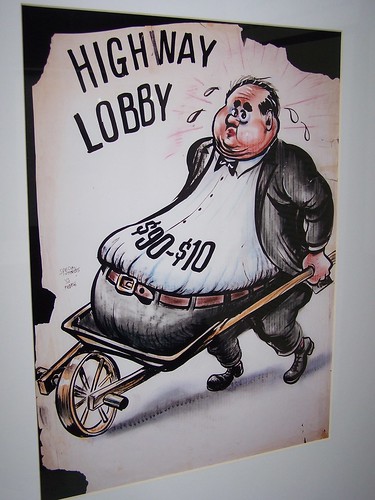Explaining how road building planning works

Image by Sammie Abbott (now deceased, former Mayor of Takoma Park) as part of the anti-freeway campaign by the citizen advocacy group, Emergency Committee on the Transportation Crisis. From an exhibit at Union Station by the DC Department of Transportation.
Relating to the point made by Robert Puentes in the new book, Century of the City, about how funding for transit goes through a brutal review process and road funding doesn't get reviewed in the same way, and is higher as well, Dean Gunderson, of Dreiling Terrones Architects, wrote about the highway planning process on another email list:
There were very few 'constituencies' in road design before the late 50's, so it's very hard to draw parallels between how something was designed & built before half a century ago -- and the processes followed today. I believe the only thing you can be sure of was the haste with which the Interstate system was laid out (designed, in a loose sense) and how it wreaked havoc on local urbanism. It might surprise some to know that the entire Interstate system was designed by military generals over a six month period (and they never left Washington, D.C. during the entire time).
What's surprising about freeway expansion projects today is the amount of 'public' involvement actually carried out, sometimes taking upwards of several years. It's just that this engagement is with local officials and metropolitan planning organizations, and not the lay public. The theory being that local officials (mayors, council members, commissioners, local public works engineers, and senior planners) represent the interests of their local communities. It's a scenario that is fraught with contention, since it's the local homeowners, renters, and businesses that will be directly impacted by such expansions (though condemnations, or environmental impacts), or indirectly (through induced land use changes), and they usually only get to see the specifics of a proposal after its on the books for potential funding. By then it's seen as a 'done deal'.
There were recent changes in the way the FHWA is required to involve local stakeholders, mostly dealing with due diligence issues to ensure local governments were included in initial environmental reviews. It's not that the locals wouldn't normally be at the table, the Feds just wanted to establish a CYA paper trail to show that invitations were extended at every step -- so they can show copies of invitation letters to that state's D.C. delegation when the shit hits the fan over time delays, cost over runs, and/or inattentiveness to local needs.
I agree with Paul regarding the need to address crumbling infrastructure now. To put it in transportation-speak, Federal Quick Start funding should be expended solely on renewal and replacement projects -- and never to improve, or ameroliate, existing Levels of Service. This equates to no new bridges, no road widenings, and no road extensions.
But not all roads are built with Federal funds (or even Federal money funneled through state DOT's), in fact, the vast majority of roads are built with local money. And, if you're an NU advocate most of the road work you should be advocating for construction will be built by either developers or local highway departments. These are all the fine grained, highly connected, mesh-work of local streets (that just happen to help make great neighborhoods) -- and barely a single Federal rule will apply to how these roads will, or won't, be built.
If you want a sea change in the role the Fed's play in highway funding, crack through the stranglehold state DOT's have on the planning process. Make federal money available for planning and designing local urban street networks in & around urban refill sites. Make these funds directly payable to local highway departments, governed by Boards/Commissions that have ordinance passing authority (and final plat signing authority) -- and require only one thing of these recipients, that the money going for these improved road networks will only be granted to districts that have TND/TOD ordinances (and the programmed roads are actually inside the pre-determined TND/TOD Districts).
You would see a whole different kind of scrambling then -- with the oddest bedfellows ever seen (Road Builders and Concrete/Asphalt Suppliers, and New Urbanists).
(reprinted with permission)
Labels: car culture and automobility, transportation planning



0 Comments:
Post a Comment
<< Home